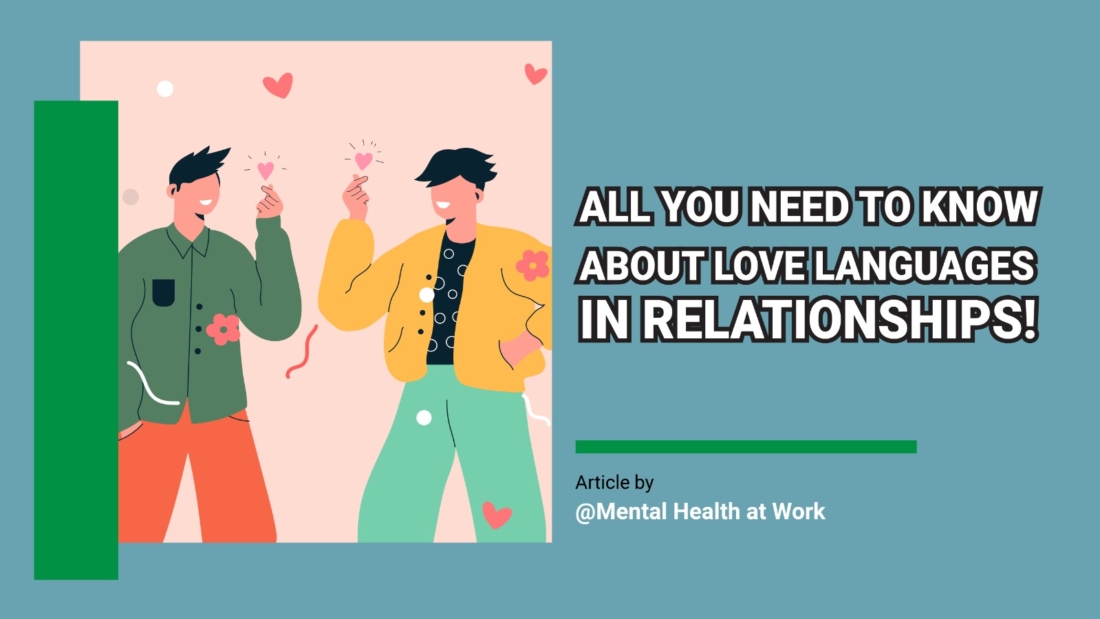Love and Relationships: Talking about Love Languages

While researching this article, I came across this little cartoon strip. While on the surface, reading this some people may relate and crack a smile, it’s problematic undertones also speak volumes(it’s sexist and ableist). However, what really got me thinking was how we, when in relationships view the “Language of love”.
But what is Love Language? How do we communicate “Love” to those around us? Can there be only 1 language of love?
That’s what we are going to explore in this article today, and try and break some myths around Love languages.
About Love Languages
The first thing to remember is : There is no single language of love.
In fact, Dr. Gary Chapman in his book The Five Love Languages, shares that people have 5 identifiable, unique, primary ways of communicating their love and care for another.
This means, that when we feel a disconnect in our relationships it’s possible that we are literally speaking different languages!
When in close and intimate relationships, the key to maintaining a healthy dynamic is open, honest communication. But what happens to communication, when people in the relationship aren’t speaking the same language? Once can imagine the ensuing confusion, and unpleasantness. It usually leads to blaming one another, and the eventual breakdown of the communication process in the relationship, with the belief that the other partner “Just doesn’t get it”.
Hence it’s important to pause and remember that just like not everyone may speak the same language fluently, not everyone may have the same vocabulary or expression for communicating love and care -and that’s where things can get complex.
What tends to happen is that we operate from our own understanding of what communication of love could be and end up being completely unaware of the ways in which love is expressed or understood.
This means that at any given point of time in a relationship when we want to express love and care or receive an affirmation of love and care, several things may be happening.
- We send out messages in a manner that is meaningful to us.
- We expect the same language to be meaningful to the person we are communicating with.
- We expect them to respond in a way that we understand.
Which is fine, provided our love languages are the same. However, more often than not this might not be the case. And, the partner with the different love language may also have the same expectations from the communication as we listed above.
These complexities are visible across all kinds of relationships and are not limited to romantic partnerships, but also parent -child, sibling and even friendship bonds.
What are the 5 love languages?
Dr. Chapman identified 5 types of love languages:
- Words of Affirmation
- Quality Time
- Receiving Gifts
- Acts of Service
- Physical Touch
It’s possible then that the love languages of the people around us are different, often due to the emotional and psychological patterns that we develop in childhood. These patterns develop based on what we perceive and witness of the world around us. This is usually an amalgamation of cultural norms and our own lived experiences, experiences of expressions of love and personal values.
All these facets give rise to a primary emotional love language, which means that this person may perceive and express love and care in a specific way. Perhaps over time, the lived experiences of the person may allow them to learn a secondary love language, but the primary mode of expression will come most naturally.
For many years, someone I was quite close to was very uncomfortable with physical touch and words of affirmation when showered on her by her peers. Initially they thought it was because she was unapproachable or aloof, and it took a long time to see that she was dealing with her own emotional journey, and despite it all, there was so much love in those friendship bonds. Once that was established, the other many efforts made by her through the years that were unnoticed in the past – meaningful gifts, showing up when in need, spending quality time together despite her circumstances – became visible.
This is important to understand because in order to become effective communicators of love and care it is important to not only identify and understand our own primary love languages but also be able to identify, understand and learn those primary love languages of those we hold dear.
Let’s take a moment to understand the five love languages in detail.
-
One of the most powerful love languages is Words of Affirmation, wherein people who are grounded in this type of emotional expression value verbal communication of love and care and also themselves communicate love and care through words that affirm.
Not just saying “I love you”, but affirming though compliments, acknowledgment and gratitude expressed, writing meaningful letters and notes, using kind and encouraging words – all of these become significant to those for whom words of affirmation are significant.
These kinds of affirming words to have the capacity to positively impact our mental and emotional health, and create the experience of being seen in the relationship as well. - When we talk about love languages we also talk about Quality Time – centered around spending meaningful time together, and the feeling of togetherness or focussed attention. We tend to spend a lot of time with our loved ones especially when we live with them, but often the distractions of everyday life may get in the way. People who value spending quality time together often find time away from distractions, paying attention to each other as meaningful and significant. This could include going out together, eating together, sharing hobbies together, and can perhaps even extend to watching TV together – provided the attention is on the 2 of you spending time together and meaningful time can be spent in this way.
- Gift giving is something that has been quite visible in social discourse, particularly around the beginning of romantic relationships and days like Valentine’s day. However, gift giving need not be simply about buying expensive gifts nor about the beginning of any relationship. The sentimental value people attach to gift giving could include little notes, handmade gifts or other sorts of gifts sometimes ‘for no reason”. The qualities here are in the spirit of giving and the idea that a person was in one’s thoughts while making of planning the gift, a visible symbol of love, as Dr Chapman puts it.
-
The next love language is that of Acts of Service – speaking to the idiom that actions speak louder than words. Those who value this love language take active steps to show their loved one they care, even if they don’t verbalise it often. This could include a lot of those invisible actions including helping with housework, offering to run errands and going an extra mile to lend support to the person they love and care about.
It’s important to remember that your partner from whom acts of service are meaningful may also value love communicated in the same way and sometime even asking what they would like you to do may be significant for them. - Finally, we have Physical Touch. This is perhaps the one we are most familiar with as its most visible across cultures and especially spotlighted in popular media. Physical touch refers to expressing affection through, physical intimacy, closeness, contact and other forms of a physical connection. This could range from brushing a hand over a loved one’s head, holding hands, hugging, cuddling, kissing. People for whom this love language is important seek closeness and physical intimacy as demonstrations of love and care, and communicate love in the same manner.
Understanding the manner of communicating love and care in any relationship dynamic is essential, not only from the perspective of what we ourselves would like to receive, but also to understand how our partners feel loved, and what we can bring in to ensure that them being valued is communicated in a manner that is meaningful to them. That said, not having the same love language need not be a dealbreaker. Learning to actively understand our significant other’s love language and explicitly communicating our own, can result in a deeply emotional, fulfilling and meaningful relationship.
So what are those love languages you can see around you, after reading this article?
If it helped make something visible to you in your relationships, write to us and let us know!
Written by Rosanna Rodrigues
 Cart is empty
Cart is empty 


